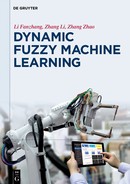At the same time, such that holds, and the membership rate of sample class divided by condition attribute is written as
where
Because there are n categories condition attribute has a division membership rate of each category, and the division membership of condition attribute for the whole sample set can be written as
where represents the rate of class samples.
In decision tree classification, attribute selection conditions are written as Here, the range of the membership rate of condition attribute for the whole sample set is 1. That is, condition attribute can determine the partition of the sample set without uncertain elements. When the membership rate of condition attribute for the whole sample set is 0. That is, condition attribute can produce a most uncertain partition of the sample set. Therefore, the greater the value of the more certain the partition. Otherwise, the partition is more uncertain. Thus, in the attribute choosing algorithm, the attribute that minimizes should be chosen as the classification attribute.
In the process of constructing the dynamic fuzzy tree, condition attribute should cover as many samples as possible to decrease the number of samples waiting to be classified. The attributes that satisfy min satisfy the above conditions. Thus, we consider the contribution of each division of the decision attribute to the partition of the whole sample set comprehensively using prok and choose the best attribute to construct the division; attributes that have already been chosen cannot be chosen again.
The pseudocode of the dynamic fuzzy tree hierarchical relationship learning algorithm can be described as Algorithm 6.1.
Algorithm 6.1 Procedure buildDFTree(DFTreeNode,U)

6.4.3Sample analysis
We used data from the literature [1] (see Tab. 6.8) to illustrate the process of dynamic fuzzy tree HRL algorithm. First, dynamic fuzzy theory was applied to the data source, and then the hierarchical learning algorithm was used to classify the dynamic fuzzy set and build a DFT.
For the Outlook condition attribute, represent the dynamic fuzzy degree of sunny, overcast, and rain.
For the Temperature condition attribute, represent the dynamic fuzzy degree of hot, mild, and cold.
For the Humidity condition attribute, represent the dynamic fuzzy degree of high and normal.
For the Windy condition attribute, represent the dynamic fuzzy degree of yes and no.
For the decision attribute of Class, represent the dynamic fuzzy degree of positive and negative.
Thus, for Quinlan’s “playtennis” training sample set, dynamic fuzzification produces the dataset in Tab. 6.9.
Tab. 6.8: Quinlan’s playtennis example.

Tab. 6.9: Quinlan’s playtennis training sample set after dynamic fuzzified.

According to the algorithm described in Section 6.4.2, we classified the data in Tab. 6.9; represent the dynamic fuzzy degree of Outlook = sunny, Temperature = hot, Humidity = high, Windy = yes, and Class = positive. represents the sample set in Tab. 6.9, where the number in the sample set has replaced the samples to simplify the representation (similarly hereinafter); that is, The process can be described as follows.
First, divide the sample set according to by each attribute:
Then, calculate the classification membership degree of divided by each attribute:
In the same way, we can obtain
Thus, we choose attribute as the branch node of the first level, which is the root node of the DFT.
When
Hence, the hierarchical attribute is and belong to the same category, and we can determine the division and end of the branch.
In the same way, when
For this scenario, the hierarchical attribute is and belong to the same category, and we can determine the division and end of the branch.
After establishing the DFT, the sample set corresponding to all the leaf nodes has the same classification. At this point, the algorithm terminates, and the tree building operations cease. The whole sample set classification is complete, and the final DFT hierarchical relationship learning results are shown in Fig. 6.7.
Figure 6.6 shows the value of the decision attribute for the classification, the value of the selected attribute of the branch node to the next layer, and the corresponding sample set for each layer. It can be seen that each layer is a partition of the attribute, which indicates the contribution of the attribute to the final classification result. For nodes that are no longer classified, the corresponding sample set belongs to the same classification. The representation of the attribute value using a dynamic fuzzy number increases the intuitiveness of the DFT.
6.5Dynamic fuzzy graph hierarchical relationship learning
In the tree structure, there are obvious hierarchical relationships among data elements. Indeed, data elements in each layer may relate to multiple elements of the next layer, but can relate to only one element of the next layer. In the graph structure, however, the relationship between nodes can be arbitrary – any two data elements in the graph may be related. Dynamic fuzzy graph structure descriptions of the classification relationship can avoid the inconsistency caused by dynamic fuzzy hierarchy trees and are more in line with real-life descriptions. According to the dynamic fuzzy graph representation method, this chapter proposes a dynamic fuzzy graph hierarchical relation learning algorithm and presents the results of an example test and comparison.
